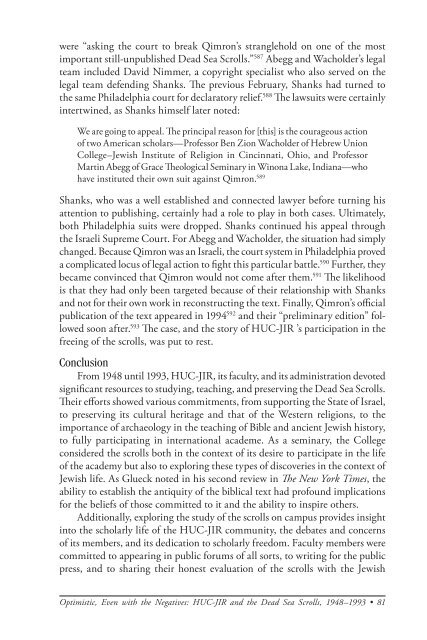The American Jewish Archives Journal, Volume LXI 2009, Number 1
The American Jewish Archives Journal, Volume LXI 2009, Number 1
The American Jewish Archives Journal, Volume LXI 2009, Number 1
You also want an ePaper? Increase the reach of your titles
YUMPU automatically turns print PDFs into web optimized ePapers that Google loves.
were “asking the court to break Qimron’s stranglehold on one of the most<br />
important still-unpublished Dead Sea Scrolls.” 587 Abegg and Wacholder’s legal<br />
team included David Nimmer, a copyright specialist who also served on the<br />
legal team defending Shanks. <strong>The</strong> previous February, Shanks had turned to<br />
the same Philadelphia court for declaratory relief. 588 <strong>The</strong> lawsuits were certainly<br />
intertwined, as Shanks himself later noted:<br />
We are going to appeal. <strong>The</strong> principal reason for [this] is the courageous action<br />
of two <strong>American</strong> scholars—Professor Ben Zion Wacholder of Hebrew Union<br />
College–<strong>Jewish</strong> Institute of Religion in Cincinnati, Ohio, and Professor<br />
Martin Abegg of Grace <strong>The</strong>ological Seminary in Winona Lake, Indiana—who<br />
have instituted their own suit against Qimron. 589<br />
Shanks, who was a well established and connected lawyer before turning his<br />
attention to publishing, certainly had a role to play in both cases. Ultimately,<br />
both Philadelphia suits were dropped. Shanks continued his appeal through<br />
the Israeli Supreme Court. For Abegg and Wacholder, the situation had simply<br />
changed. Because Qimron was an Israeli, the court system in Philadelphia proved<br />
a complicated locus of legal action to fight this particular battle. 590 Further, they<br />
became convinced that Qimron would not come after them. 591 <strong>The</strong> likelihood<br />
is that they had only been targeted because of their relationship with Shanks<br />
and not for their own work in reconstructing the text. Finally, Qimron’s official<br />
publication of the text appeared in 1994 592 and their “preliminary edition” followed<br />
soon after. 593 <strong>The</strong> case, and the story of HUC-JIR ’s participation in the<br />
freeing of the scrolls, was put to rest.<br />
Conclusion<br />
From 1948 until 1993, HUC-JIR, its faculty, and its administration devoted<br />
significant resources to studying, teaching, and preserving the Dead Sea Scrolls.<br />
<strong>The</strong>ir efforts showed various commitments, from supporting the State of Israel,<br />
to preserving its cultural heritage and that of the Western religions, to the<br />
importance of archaeology in the teaching of Bible and ancient <strong>Jewish</strong> history,<br />
to fully participating in international academe. As a seminary, the College<br />
considered the scrolls both in the context of its desire to participate in the life<br />
of the academy but also to exploring these types of discoveries in the context of<br />
<strong>Jewish</strong> life. As Glueck noted in his second review in <strong>The</strong> New York Times, the<br />
ability to establish the antiquity of the biblical text had profound implications<br />
for the beliefs of those committed to it and the ability to inspire others.<br />
Additionally, exploring the study of the scrolls on campus provides insight<br />
into the scholarly life of the HUC-JIR community, the debates and concerns<br />
of its members, and its dedication to scholarly freedom. Faculty members were<br />
committed to appearing in public forums of all sorts, to writing for the public<br />
press, and to sharing their honest evaluation of the scrolls with the <strong>Jewish</strong><br />
Optimistic, Even with the Negatives: HUC-JIR and the Dead Sea Scrolls, 1948–1993 • 81

















